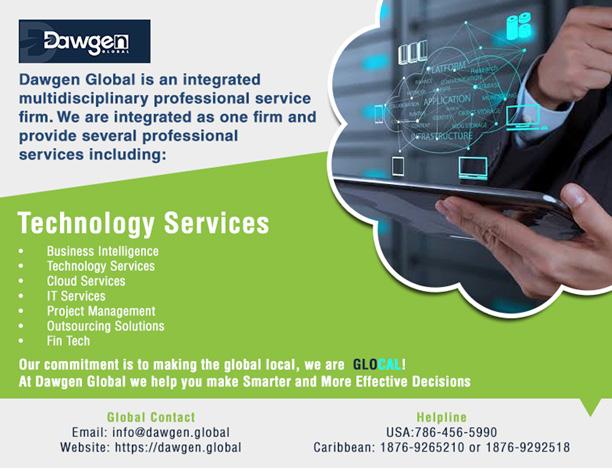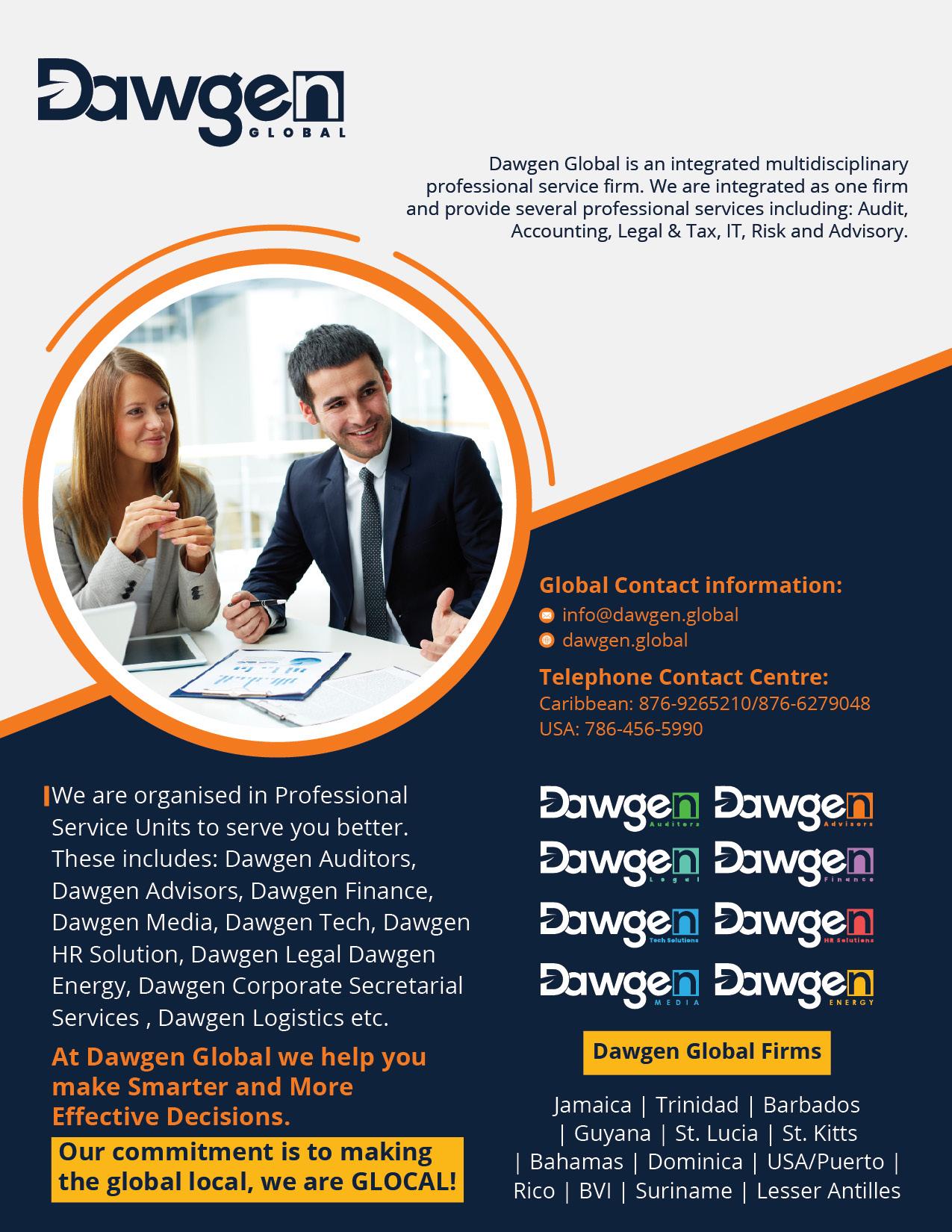
11 minute read
Managing Risk, Exploiting Opportunities in a Dynamic Business Environment
By: Rose M. Thompson, DBA, MBA, CPA, CGMA
Introduction
Advertisement
The increasing uncertainty, volatility, and complexity of the global business environment due mainly to geopolitical tensions, exponential disruptive technologies, cyber threats, regulatory reforms, slowing global growth, money laundering, significant natural disasters, and other emerging developments create significant potential risks that, if not managed effectively, can negatively impact the ability of organizations to achieve their business objectives. This changing risk landscape also presents opportunities that business leaders can exploit to create value for stakeholders. With the increase in frequency, and complexity of risks that organizations now face, it is important to more effectively manage risks while exploiting opportunities within an integrated risk management framework.
Although risk management is a proactive process that considers both upside risk and downside risk, and seeks to minimize the impact of uncertainty and negative outcomes while exploiting opportunities, its activities are traditionally uncoordinated, ad hoc and siloed. Moreover, risk management focuses mainly on operational and compliance related risks, while ignoring strategic and emerging risks, the risks most likely to significantly impact an entity’s ability to achieve its business objectives. Consequently, risk management processes are considered to be ineffective and not adding value to decision making. As organizations navigate uncertainties that create complex and interconnected risks to their business models and operations the need for a robust enterprise-wide risk management (ERM) approach has never been greater. In this dynamic business environment, organizations need to be more adaptive and resilient to change. It is also important for business leaders in general, and particularly, senior management to develop a mindset of thinking strategically about how to manage risks created by the uncertainties in the internal and external operating environment.
ERM, which is an iterative process involves identifying, assessing, and treating uncertainty and related risks as well as opportunities that could affect the outcomes of an organization’s objectives. Importantly, ERM processes consider risk in the strategy-setting process and provide the board of directors and managers with a better understanding of how risk affects performance. ERM also provides confidence that all levels of the organization are attuned to the risks that can significantly impact strategy and performance, and that these risks are being proactively managed. Leading frameworks such as the Committee of Sponsoring Organizations of the Treadway Committee (COSO) framework (2017), Enterprise Risk Management – Integrating with Strategy and Performance, and the International Organization for Standardization’s (ISO) standard, ISO 31000:2018 - Risk Management guidelines provide approaches that can assist organizations to develop the culture, capabilities and practices integrated with strategy-setting in managing risk to create, preserve, and realize value. These principles-based approaches to risk management are applicable to organizations of all sizes. Although smaller organizations are typically faced with less organizational complexity and bureaucracy, they can also benefit from a strategic and structured approach to risk management.
What is the Board of Directors’ Role in Enterprise Risk Management?
Traditionally, ERM has played a strong supporting role at the board level. Now, boards are increasingly expected to provide oversight of ERM. The ERM framework provides important considerations for boards in defining and addressing their risk oversight responsibilities. These considerations include governance and culture; strategy and objective-setting; performance; information, communications and reporting; and the review and revision of practices to enhance entity performance (COSO, 2017).
The board’s risk oversight role may include, though not limited to: Reviewing, challenging, and concurring with management on: Proposed strategy and risk appetite. Alignment of strategy and business objectives with the entity’s stated mission, vision, and core values. Significant business decisions including mergers, acquisition, capital allocations, funding, and dividend related decisions. Response to significant fluctuations in entity performance or the portfolio view of risk. Responses to instances of deviation from core values. Approving management incentives and remuneration. Participating in investor and stakeholder relations.
To become aware of the risk mindset of management within an organization, the board can ask senior management, not just the chief risk officer, to address questions such as: articulate how risk is considered in the selection of strategy or business decisions? Can they clearly articulate the entity’s risk appetite and how it might influence a specific decision? The resulting conversation may provide insights on what the mindset for risk taking is like in the organization. Boards can also ask senior management to discuss not only the risk processes but also the risk culture. For example: How does the culture enable or inhibit responsible risk taking? What lens does management use to monitor the risk culture, and how has that changed? As things change, and things will change whether or not they are on the entity’s radar – how can the board be confident of an appropriate and timely response from management?
ERM, over the long-term, can also enhance enterprise resilience, that is, the ability to anticipate and respond to change (COSO, 2017). ERM assists organizations to identify factors that represent not just risk, but change, and how the change could impact performance that may require a shift in strategy. By observing change more clearly, an organization can frame its own plan; for example, should it defensively pull back or invest in a new business? ERM provides an effective framework for boards to assess risk and embrace a mindset of resilience.
Does Management Play a Role in Enterprise Risk Management?
The overall responsibility for managing risk to an organization resides with management. However, it is important for management to go further by enhancing the conversation with the board and stakeholders about ERM to gain a competitive advantage. This begins by positioning ERM capabilities as part of selecting and refining a selected strategy. Through this process, management will gain a better understanding of how the consideration of risk may impact the choice of strategy. ERM enriches management’s conversation by adding perspective to the strengths and weaknesses of a chosen strategy as conditions change, and how well the strategy fits with the organization’s mission, vision, and core values (COSO, 2017). Moreover, it provides management with the confidence that they have examined alternative strategies and considered the input of individuals in the organization who will implement the selected strategy.
Choosing a strategy requires structured decision making that analyzes risk and aligns resources with the mission and vision of the organization. Once a chosen strategy is implemented, ERM provides an effective way for management to fulfill its role, knowing that the organization is attuned to risks that can impact strategy and is managing these risks effectively. Applying ERM assists to create trust and instill confidence in stakeholders in the current dynamic business environment.
What is the Role of the Accounts and Finance Professionals in Risk Management?
To better deal with uncertainties, the demands have never been greater from boards and management for more comprehensive, connected and insightful information, better understanding of opportunity and risk, and deeper market and competitor knowledge. To achieve success, business requires taking risks and seizing opportunities. The accounts and finance professional’s primary role in ERM is not solely to mitigate risk, but to promote and facilitate the management of risk
and opportunity in support of the creation, preservation and realization of value (International Federation of Accountants, 2019). This involves being focused on the benefits of intelligent risk-taking in addition to mitigating and controlling risk. To add significant value to an entity, accounts and finance professionals must be seen as forward-looking risk experts providing valuable insights to manage risk that supports their organizations respond to uncertainties and to achieve the business objectives.
Managing risk using a proactive and integrated approach has several advantages. Organizations that integrate ERM throughout the various functions can realize many benefits, including, though not limited to:
Improved accountability and effective governance: An organization’s governance function is comprised of several key risk management roles. These roles include assisting to integrate risk management into strategy, establishing risk appetite and risk tolerances, defining risk management roles and responsibilities, benchmarking, and reviewing how risk is managed within the entity.
Enhanced ability to identify, assess, and manage risk enterprise-wide: Organizations face numerous risks that can affect the various functions in the entity. Sometimes a major risk can originate in one part of an entity but impact a different part. As a result, it is important that enterprisewide risk are identified, assessed, and managed efficiently and effectively to improve and sustain performance.
Increasing positive outcomes and advantages while reducing negative surprises: ERM allows organizations to improve their ability to identify and prioritize risks, establish appropriate risk responses, reducing surprises and related costs or losses, and exploiting opportunities.
Improved understanding of risk interdependencies: Risks are often treated in silos, however, risks are becoming more and more interdependent. For example, in financial institutions, a risk that originates in the credit function can have significant impact on the treasury and operations functions. The ERM framework provides an approach to identify and manage inter-function risks.
Increasing the range of opportunities: By considering all possibilities – both positive and negative aspects of risk – entities can identify new opportunities and unique challenges Reducing performance variability: For several organizations, the challenge is less with surprises and losses and more with variability in performance. Delivering results ahead of schedules or beyond expectations may cause concerns similar to performing below schedules and expectations. ERM allows organizations to anticipate risks that could affect performance and enable them to establish required actions to minimize disruption and maximize opportunity.
Improving resource deployment: Assuming that resources are usually finite, obtaining robust information on key risks allows organizations to assess the overall resource requirements, prioritize deployment of resources, and enhance allocation of resources.
Enhance organizational resilience: An organization’s medium- and long-term viability depends on its ability to anticipate and respond to change, which is facilitated by effective ERM. As business complexity increases, enhancing organizational resilience allows entities to increase their ability to return to an acceptable level of performance in a reasonable period of time after a risk event has occurred.
Risk Management going Forward
The increased uncertainty, volatility and unpredictability in the global economy have created new and more complex challenges for risk management. ERM will be an important part of how an organization manages, sustains and improve performance during these times. Regardless of the type and size of an entity, the chosen strategies must be consistent with its vision, mission, and core values. Therefore, it is critical that organizations establish processes that drive effective responses to change, including agile decision making, the ability to respond in a consistent manner, and the adaptive capacity to pivot and reposition while maintaining high levels of trust among stakeholders.
There are several trends in this dynamic business environment that will have an effect on ERM. These trends include:
Building stronger organizations: As organizations become better at integrating ERM with strategy and performance, an opportunity to strengthen resilience will occur. By becoming aware of the risks that will have the most significant impact on the organization, ERM can be used to establish capabilities that allow entities to respond early to these potential risk events, which will also provide new opportunities for these entities.
Managing the exponential increase of data: As increased data becomes available from both inside and outside the entity, and structured in new ways, the speed at which data can be analyzed will require the ERM framework to be modified to manage potential risks from this trend. Advanced analytics and data visualization tools will be valuable in helping management understand risk and its impact (both positive and negative) on the achievement of business objectives.
Leveraging artificial intelligence and automation: It is a widely held belief that we have entered the era of automated processes and artificial intelligence. Therefore, it is important that the impact of these emerging disruptive technologies be considered in ERM practices to enhance the overall effectiveness of risk management by leveraging new capabilities such as building controls directly into processes, and prioritizing areas for monitoring. Relationships, trends, and patterns that were previously not recognizable can now be identified, providing a rich source of information that is critical to managing risk. An example is identifying potential risk events in real time to allow preventive action to be taken.
Managing the cost of risk management: A concern frequently expressed by many business executives is the cost of risk management, compliance processes, and control activities in comparison to the value gained. As ERM practices evolve, it will become important for activities that encompass governance such as risk, compliance, and control to be cost-efficiently coordinated to provide maximum benefit to the organization. This may represent one of the best opportunities for ERM to redefine its importance to the organization.
In summary, to consistently provide the benefits outlined in an ERM framework, as an iterative process, ERM will need to change and adapt to the future. By embracing the right focus, organizations can obtain benefits from ERM that significantly outweigh the investments and also provide entities with confidence in their ability to navigate the future. The right focus involves engaging employees throughout the organization which can be achieved by implementing an active programme to create a risk-aware culture that encourages ethical employee behavior, constructive challenges, appropriate incentives, and transparency.

References Committee of Sponsoring Organizations of the Treadway Committee (COSO), (June, 2017).
Enterprise Risk Management – Integrating with Strategy and Performance. www.coso.org
International Federation of Accountants (IFAC), (2019). Enabling the Accountant’s role in effective enterprise risk management. www.ifac.org


About Dawgen Global
Our commitment is to making the global local, we are GLOCAL!
At Dawgen Global we help you make Smarter and More Effective Decisions
Global Contact
Email: info@dawgen.global
Website: https://dawgen.global
Helpline:
USA: 786-456-5990
Caribbean: 1876-9265210 or 1876-9292518








